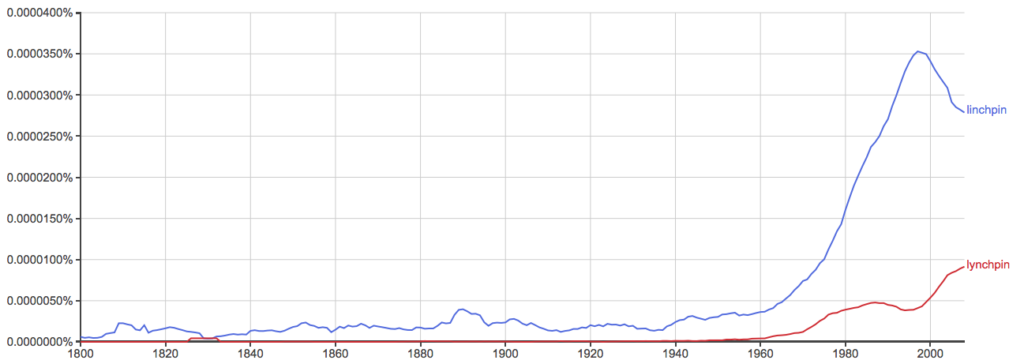When an entire concept or operation hinges on a single element, we call that element a linchpin. In less grandiose contexts, a linchpin is also a small device inserted through a hole at the end of a rod to keep things from falling off of it.
Like many words, linchpin has an alternative spelling: lynchpin. You’ve probably even seen lynchpin in published writing, like serious journalism or careful prose.
So which version is correct? Can you use either word in any context? Continue reading to learn more about these spellings.
What is the Difference Between Lynchpin and Linchpin?
In this post, I will compare lynchpin vs. linchpin. I will use each word in at least one example sentence, so you can see how it appears in context.
Plus, I will outline a helpful memory tool that makes choosing either lynchpin or linchpin much easier for your own writing.
When to Use Linchpin
 What does linchpin mean? Linchpin is a noun. Its original meaning is a locking pin inserted into a shaft to keep wheels or other parts from falling off the end.
What does linchpin mean? Linchpin is a noun. Its original meaning is a locking pin inserted into a shaft to keep wheels or other parts from falling off the end.
Less literally, linchpin can also mean a central component that holds important parts of a device together.
Many writers use linchpin in a strictly metaphorical sense to refer to the most important part of something.
For example,
- The mechanic installed a linchpin on the end of the axle to keep the dustcaps from falling off of the bearing assembly.
- LeBron James was the linchpin around which the entire Cleveland offense revolved.
When to Use Lynchpin
 What does lynchpin mean? Lynchpin is a variant spelling of the same noun. It is used somewhat frequently, although it is nonstandard and incorrectly suggests an association with lynch.
What does lynchpin mean? Lynchpin is a variant spelling of the same noun. It is used somewhat frequently, although it is nonstandard and incorrectly suggests an association with lynch.
Lynchpin is actually closer to the original spelling of the word in Middle English, which derived from an Old English word lynis.
Here are a few examples of lynchpin in a sentence,
- The police saw underboss Salvatore Gravano as the lynchpin around which their systematic dismantling of the Italian Mafia was centered.
- Replacing the wheel properly involves removing a lynchpin from the end of the axle.
Even though lynchpin is closer to the original spelling of the root word, it is less common today. The graph below shows the relative usage of linchpin vs. lynchpin over time,

As you can see, linchpin has been the preferred spelling for at least 200 years.
Trick to Remember the Difference
Today, you should use linchpin, as it is the standard spelling of this word. Lynchpin is not uncommon, but stick with linchpin unless you have a good reason to do otherwise.
Since linchpin has two I’s, and a linchpin is a locking pin, use the spelling of the word as a memory tool to help you remember which version to use.
Summary
Is it linchpin or lynchpin? A linchpin is a locking mechanism on the end of an axle or other shaft that ensures all components remain on it.
- Linchpin is the standard spelling of the word.
- Lynchpin is a variant spelling that is somewhat common but not preferred by most writers or dictionaries.
Contents
